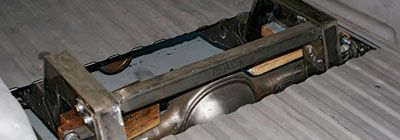
When a frame has been step-notched to clear the rearend, it's obviously going to command more vertical clearance from the sheetmetal above, and in a truck, this is usually smack dab in the middle of the bed floor. As classic truckers, we don't usually haul much in our trucks' beds, depending on its state of finish, but that doesn't mean we necessarily want a big "hump" in the bed floor, whether it be for aesthetics' sake or from a utilitarian standpoint. Regardless, if your truck is a show-winner or a low-buck beater, making it sit low is full of compromises, and the lower you go, the more you have to give up-period.
Builders are constantly trying to find the middle ground between low/cool and comfort/functionality, which is like searching for the Holy Grail, but that's what keeps new and fresh ideas circulating. In the case of the step notch, most opt to cut the bed floor out around the area and build a new section over it, leaving the previously mentioned hump to occupy a big portion of the formerly flat space. What other option is there, you ask?
With classic trucks gaining even more popularity in the last few years, further attention has been paid to the details that are taking them to the next level, and bed floors are being raised with the bar. Moving the whole bed floor to clear frame mods such as a step notch is a considerable amount of work, but it leaves the bed with a more stock look when done right, not to mention a flat bed floor.
Raising a bed floor is not for the faint of heart, but it is well worth the effort. There are a few ways to go about it, and my plans changed completely three times until I figured it out. The first plan was to use a repop bed floor for a Chevy truck since there isn't a direct-replacement floor for the '67-72 F-100 as of yet. I figured I'd use my trusty Miller welder and a plethora of grinders to make a new Chevy floor work. After looking at the cost and my shrinking window of time, I thought I'd whip up a new floor using rectangle tubing for the frame and half a dozen or so 16x48-inch bed floor patch panels welded together. Well, when I took the truck's bed, flipped it over, and really scrutinized how it was put together from the factory, it became apparent that I wouldn't need much more than my tools and a couple of those floor patches from Blue Oval Truck Parts to fix the hole I'd cut in the first place when I planned on ditching the stock tin.
Follow along and see how you can level the playing field, or at least your bed floor.